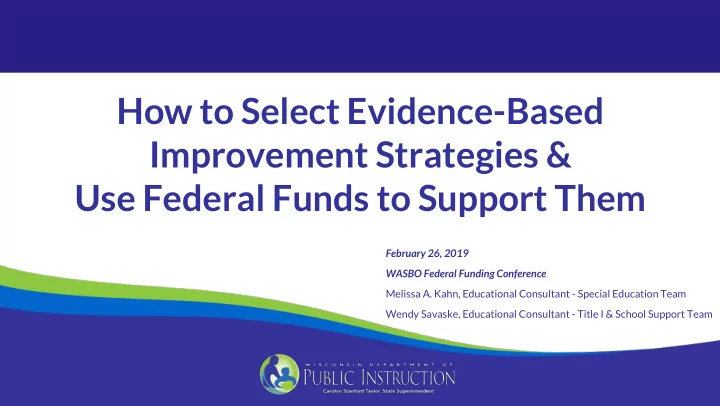

How to Select Evidence-Based Improvement Strategies & Use Federal Funds to Support Them February 26, 2019 WASBO Federal Funding Conference Melissa A. Kahn, Educational Consultant - Special Education Team Wendy Savaske, Educational Consultant - Title I & School Support Team
This session... WILL: WILL NOT: ● Give you a 30,000 foot ● Give you an “in the weeds” perspective perspective ● Ground you in critical adaptive ● Provide technical next steps and a mindsets and key information checklist for compliance purposes ● Open opportunities for ● Be DPI telling you what to do co-development/feedback
Coherent Continuous Improvement for Advancing Equity How do we know which of the investments we’re making lead to the results we want for Wisconsin students?
Federal Identifications: Focus on Responsiveness to Needs Individuals with Disabilities Education Act Every Student Succeeds Act District Level School Level LEA Determinations Targeted Support (subgroups) Racial disproportionality Additional Targeted Support (subgroups) (identification, placement, discipline) Comprehensive Support (all students/school)
Continuous Improvement Process ESEA improvement plan for focus and/or priority schools IDEA improvement plan(s) Educator Effectiveness (SLO and PPG) Continuous improvement of adult practices to improve School and district student outcomes improvement plans
What is an Evidence-Based Improvement Strategy? Evidence-based improvement strategies are practices or programs that have evidence to show they are effective at producing results and improving outcomes when implemented as intended.
Evidence for ESSA ● Under No Child Left Behind (NCLB), districts and schools were called to use “scientifically-based research” as the foundation for education programs and interventions. ● This has been replaced by “evidence-based interventions” under the Every Student Succeeds Act (ESSA).
Four Tiers of Evidence Tier 1 Strong Evidence : supported by one or more well-designed and well-implemented randomized control experimental studies. Tier 2 Moderate Evidence : supported by one or more well-designed and well-implemented quasi-experimental studies. Tier 3 Promising Evidence : supported by one or more well-designed and well-implemented correlational studies (with statistical controls for selection bias). Tier 4 Demonstrates a Rationale : practices that have a well-defined logic model or theory of action, are supported by research, and have some effort underway by an SEA, LEA, or outside research organization to determine their effectiveness.
Why are the Tiers Important? ● ESSA Identified Schools (CSI, ATSI, TSI): ○ Evidence-Based Improvement Strategies are required to have strong, moderate, or promising evidence (Tiers 1–3) to support them. ● All other programs under Titles I–IV can rely on Tiers 1–4.
Federal Funding Federal Allowable Expenditures Funding Source Title I - ● Schoolwide: ○ Professional learning and coaching & resources to implement the evidence-based improvement strategy aligned to the schoolwide plan ● Targeted Assistance : ○ Professional development with Title I funds focuses on staff who provide direct support to Title I students and is aligned with these students’ needs. ○ Title I funds are used to support additional for identified students instruction using an evidence- based improvement strategy aligned to an identified need.
Federal Funding Federal Allowable Expenditures Funding Source Title IIa ● High quality professional learning and coaching aligned to the Evidence-Based Improvement Strategy ● Contracted services for professional learning ● Conferences aligned to Evidence-Based Improvement Strategy ● PD Supplies for a meetings (chart paper, markers, binders etc.)
Federal Funding Federal Allowable Expenditures Funding Source CSI Planning Stipends, salaries, fringe for school stakeholders to complete continuous ● improvement activities (such as needs assessment with root cause analysis, Grant research and identifying an evidence-based improvement strategy, identifying resource inequities, and creation of an improvement aligned to identified needs) Professional development and/or purchased services for continuous ● improvement Supplies for stakeholder meetings (as outlined by district policy ● Purchase materials to implement programs or practices aligned to the ● research requirements (Tiers 1-3) of ESSA, and professional development for staff to support the improvement plan.
Federal Funding Federal Allowable Expenditures Funding Source IDEA ● All Students ○ Coordinated early intervening services: may elect to reserve up to 15% of IDEA funds for professional development for teachers/school staff to deliver scientifically based academic instruction and behavioral interventions and providing educational and behavioral evaluations, services, and supports. . ○ Title I Schoolwide Set-aside (calculation instructions, here) ● Students with IEPs: ○ Personnel, purchased services, capital and non-capital objects to support implementation of evidence-based improvement strategies (allowable costs, here)
Implementation Drivers Reliable Benefits Consistent Use of Innovations Fidelity Systems Coaching Intervention Organization Drivers Competency Drivers Facilitative Training Administration Integrated Decision Support Selection & Data System Compensatory Leadership Drivers Technical Adaptive
The Hexagon An Exploration Tool NIRN NATIONAL IMPLEMENTATION RESEARCH NETWORK National Implementation Research Network. The Hexagon: An Exploration Tool. 2018.
Turn & Talk Now that you have a 30,000 foot view of the tool, how does this connect to your intended impact on children?
Coherent Continuous Improvement for Advancing Equity How do we know which of the investments we’re making lead to the results we want for Wisconsin students?
Interested in Helping? Melissa A. Kahn melissa.kahn@dpi.wi.gov 608-266-3126 Wendy Savaske wendy.savaske@dpi.wi.gov Provide contact information to participate in development of tools/resources 608-267-7461
Recommend
More recommend